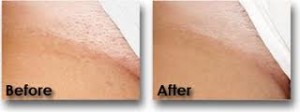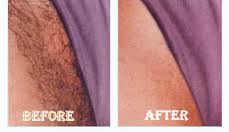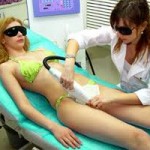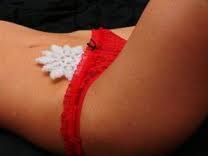In the upcoming trailer for the “Sex and the City†movie, Samantha admonishes Miranda for “growing a national forest†around her bikini area. It may be funny on the big screen, but the unsightly inflamed, itchy bumps that often accompany the hair removal process have some thinking twice about cleaning up their bikini areas. It doesn’t have to be such an excruciating experience. Dr. David Colbert, founder of the New York Dermatology Group, recommends five ways to minimize the pain and inflammation.
— Laser Hair Removal
 “Before you deal with a lifetime of bikini bumps, why not think of laser hair removal?†Colbert suggested. “Then, you just have to deal with the bumps during the procedure. And, it’s actually cheaper than waxing over a lifetime.â€
“Before you deal with a lifetime of bikini bumps, why not think of laser hair removal?†Colbert suggested. “Then, you just have to deal with the bumps during the procedure. And, it’s actually cheaper than waxing over a lifetime.â€
If you choose this method, do not wax one month before the procedure and make sure to show up to your appointment clean-shaven.
Colbert advised that your bikini area should have no active infections during the procedure.
Laser hair removal is around $300 per session and usually takes three to five sessions to complete, he said.
— Use a Man’s Razor
If you are going to shave, opt for a man’s razor.
“The industry is going to hate me for this,†Colbert said, laughing. “But, a lot of times, a man’s blade will work better because a woman’s blade is dulled down.â€
Razor rash, or razor burn, is usually caused by either using a dull razor or not shaving the correct way. This causes the hair to grow back into the skin, creating a red bump or rash. In some cases, bacteria in the area can cause the bumps to get infected, meaning they will get bigger, more painful, and likely be filled with pus.
Home Remedies
 Hydrocortisone cream is an easy way to ease the burning of razor rash. Apple cider vinegar, applied with a cotton ball, works to ease the burn and also helps to stave off infection. As with most burns, aloe vera can work wonders to ease the pain. Chamomile tea bags (let them cool first!) and witch hazel are other popular remedies. A paste made by dissolving two uncoated aspirin in a little bit of water can help; apply it liberally, leave it on for 30 seconds, and rinse off with warm water. Moisturizers that do not contain perfumes or dyes, such as Vitamin E oil, will help to lessen the pain and get rid of the rash.
Hydrocortisone cream is an easy way to ease the burning of razor rash. Apple cider vinegar, applied with a cotton ball, works to ease the burn and also helps to stave off infection. As with most burns, aloe vera can work wonders to ease the pain. Chamomile tea bags (let them cool first!) and witch hazel are other popular remedies. A paste made by dissolving two uncoated aspirin in a little bit of water can help; apply it liberally, leave it on for 30 seconds, and rinse off with warm water. Moisturizers that do not contain perfumes or dyes, such as Vitamin E oil, will help to lessen the pain and get rid of the rash.
Prevention
In many cases, razor rash can be prevented by using proper shaving techniques. It is important to use a sharp blade, so replace the blade as often as necessary. Dry shaving will almost certainly lead to a rash, so be sure to keep the area lubricated. Shave with the grain of the hair, not against it. Use shaving creams or gels that do not have perfumes or dyes that could irritate the sensitive bikini-line skin. Some people exfoliate the skin after cleansing (but before shaving) to minimize bumps. Colbert said he swears by one product: Aveeno Therapeutic Shaving Gel, which has a natural, oatmeal base.
“If it can work for a man’s beard, it can work for a woman’s bikini area,†Colbert said.
The gel does a few things: First, it helps the razor glide over the skin; second, it moisturizes the skin and it also soothes the irritated skin during and after the shave, Colbert said.
Cleaning the razor with rubbing alcohol after each use will kill any bacteria on the blade that could cause an infection. Although it may seem as if there are a lot of steps to perfecting the bikini line shave, they do not take much time — and they certainly beat the alternative of a painful rash.
— Wash with Antibacterial Soap
 Do this before and after your waxing procedure, Colbert warned.
Do this before and after your waxing procedure, Colbert warned.
Antibacterial soaps guard against bacteria, which can get into the empty hair follicles, thus causing an infection. If this happens, the already-inflamed spot can become angrier.
— Apply a Thin Layer of Hydrocortisone Cream or Neosporin
A reasonable amount of hydrocortisone cream will reduce inflammation and itchiness, Colbert said.
Neosporin will either clear up an existing infection or stave off an infection before it begins, he added.
“Inflammation is caused by pulling the hair follicle up from the root, so there is almost always some; especially after a waxing procedure is done,†he said. “It’s the luck of the draw. People who have curlier, thicker hair are more likely to have inflammation than people who have thinner, straighter hair.â€
